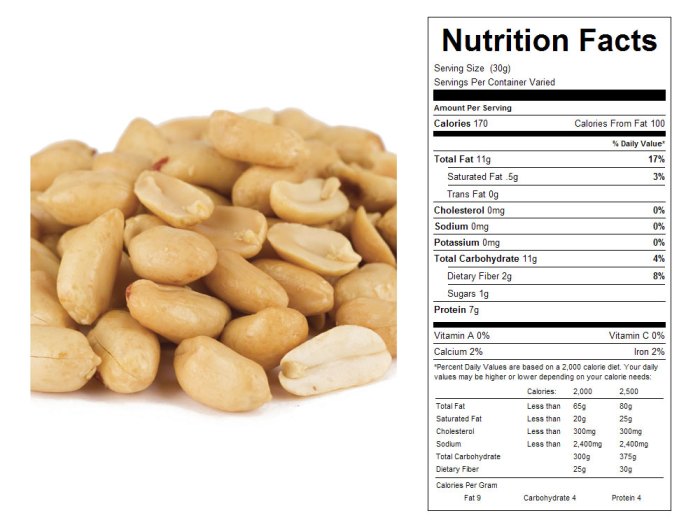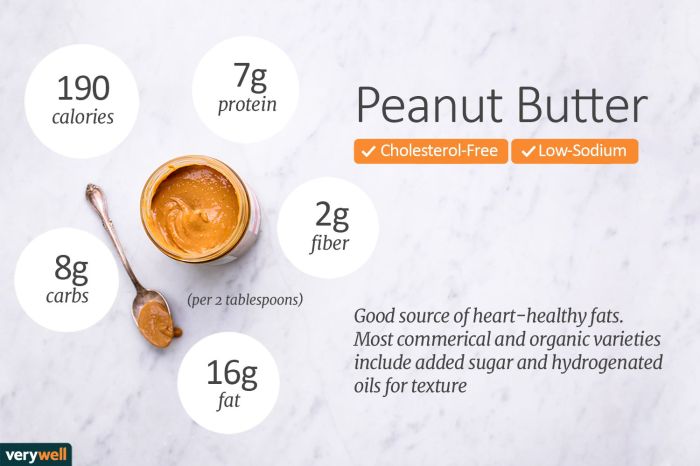Nutritional Composition of Peanut Butter: Peanut Butter Nutrition Facts

Peanut butter nutrition facts – Peanut butter is a popular and convenient food enjoyed worldwide. Its nutritional profile makes it a source of several essential nutrients, contributing to a balanced diet. However, the nutritional content can vary depending on the type of peanut butter and any added ingredients. This section details the macronutrient and micronutrient composition of peanut butter, highlighting differences between various types.
Macronutrient Composition of Peanut Butter
The macronutrient content of peanut butter primarily consists of protein, fat, and carbohydrates. The following table provides a typical breakdown for a two-tablespoon serving (approximately 32 grams):
| Nutrient | Amount per serving (grams) | % Daily Value | Notes |
|---|---|---|---|
| Protein | 7 | 14% | Provides essential amino acids. |
| Fat | 16 | 25% | Primarily unsaturated fats (monounsaturated and polyunsaturated). Contains some saturated fat. |
| Carbohydrates | 7 | 2% | Mostly in the form of fiber and sugars. |
Micronutrient Content of Peanut Butter
Beyond macronutrients, peanut butter offers several important micronutrients. These contribute to various bodily functions and overall health.
Peanut butter is a good source of:
- Vitamin E: A powerful antioxidant that protects cells from damage.
- Niacin (Vitamin B3): Crucial for energy metabolism and DNA repair.
- Magnesium: Involved in numerous enzymatic reactions and muscle function.
- Potassium: Important for maintaining healthy blood pressure.
- Biotin (Vitamin B7): Essential for cell growth and metabolism.
- Manganese: Plays a role in bone health and metabolism.
Nutritional Profile Comparison of Different Peanut Butter Types
The nutritional values of peanut butter can vary depending on the type. This table compares creamy, crunchy, natural, and reduced-fat varieties, keeping in mind that these values are approximate and can change based on the brand and specific ingredients.
| Type of Peanut Butter | Fat (grams/serving) | Protein (grams/serving) | Sugar (grams/serving) | Sodium (mg/serving) | Notes |
|---|---|---|---|---|---|
| Creamy | 16-18 | 7-8 | 1-3 | 100-200 | Smooth texture, often contains added salt and sugar. |
| Crunchy | 16-18 | 7-8 | 1-3 | 100-200 | Contains whole peanuts, providing added fiber and texture. |
| Natural | 16-18 | 7-8 | 0-1 | 0-50 | Typically contains only peanuts and possibly salt. |
| Reduced-Fat | 8-12 | 7-8 | 1-3 | 100-200 | Lower in fat but may have a slightly different taste and texture. Often contains added stabilizers. |
Health Benefits Associated with Peanut Butter Consumption

Peanut butter, a beloved spread enjoyed worldwide, offers a surprising array of health benefits beyond its delicious taste. Its nutritional profile, rich in healthy fats, protein, and fiber, contributes significantly to overall well-being, impacting various aspects of health, from cardiovascular function to blood sugar control and weight management.
Peanut Butter and Heart Health
The monounsaturated fats found abundantly in peanut butter are beneficial for heart health. These healthy fats help lower LDL (“bad”) cholesterol levels while maintaining or even slightly raising HDL (“good”) cholesterol. This favorable lipid profile reduces the risk of heart disease and stroke. Studies have shown a correlation between regular consumption of nuts, including peanuts (and thus peanut butter), and a decreased incidence of cardiovascular events.
The presence of other beneficial components like magnesium, potassium, and vitamin E further contributes to its cardioprotective effects. For example, a study published in the “Journal of the American Heart Association” found that individuals who regularly consumed nuts had a lower risk of coronary heart disease compared to those who did not.
Peanut Butter and Blood Sugar Management, Peanut butter nutrition facts
Peanut butter’s impact on blood sugar levels is multifaceted. Its protein and fiber content promote satiety, helping to prevent overeating and subsequent blood sugar spikes. The slow release of carbohydrates from peanut butter, coupled with its fiber content, contributes to a more gradual rise in blood glucose levels compared to refined carbohydrates. This can improve insulin sensitivity, making it a suitable addition to a balanced diet for individuals managing diabetes or aiming to prevent its development.
The combination of protein and healthy fats also contributes to improved insulin response, stabilizing blood sugar fluctuations throughout the day. For instance, including a small amount of peanut butter in a meal or snack can help prevent a rapid increase in blood glucose levels after eating refined carbohydrates.
Peanut Butter and Weight Management
Peanut butter’s role in weight management stems from its high protein and fiber content. Protein promotes satiety, keeping you feeling full for longer periods, thus reducing overall calorie intake. Fiber also contributes to satiety and aids in digestion. Despite its caloric density, the combination of protein, fiber, and healthy fats in peanut butter leads to increased feelings of fullness, potentially reducing overall calorie consumption and aiding in weight management or maintenance.
A well-planned diet incorporating peanut butter as part of a balanced meal can be a beneficial strategy for weight control, provided portion sizes are managed appropriately. For example, substituting a less nutritious snack with a measured serving of peanut butter can help satisfy cravings without significantly impacting overall caloric intake.
Potential Drawbacks and Considerations

While peanut butter offers numerous nutritional benefits, it’s crucial to acknowledge potential drawbacks and considerations for safe and healthy consumption. Understanding these aspects allows for informed choices and helps mitigate any potential risks associated with incorporating peanut butter into one’s diet.Peanut butter, while a nutritional powerhouse for many, presents potential challenges for some individuals. These challenges primarily stem from allergic reactions and the high caloric and fat content, necessitating mindful consumption.
Furthermore, sodium content variations across brands necessitate consideration for those managing blood pressure.
Peanut Allergies and Allergic Reactions
Peanut allergies are a serious concern, potentially life-threatening. A peanut allergy is an immune system response where the body mistakenly identifies peanut proteins as harmful invaders. This triggers a cascade of reactions, ranging from mild to severe. Mild reactions can include itching in the mouth, hives, and mild swelling. More severe reactions, however, can involve difficulty breathing, a drop in blood pressure (anaphylaxis), and even loss of consciousness.
Individuals with known peanut allergies must strictly avoid all peanut products, including peanut butter. Early diagnosis and the use of epinephrine auto-injectors (like EpiPens) are critical in managing severe allergic reactions.
High Calorie and Fat Content and Potential Weight Gain
Peanut butter is calorie-dense, primarily due to its high fat content, which is largely unsaturated fat, beneficial for heart health. However, excessive consumption can lead to significant calorie intake, contributing to weight gain if not balanced with overall dietary intake and physical activity. The following table illustrates the calorie content of different serving sizes:
| Serving Size | Approximate Calories |
|---|---|
| 1 tablespoon (16g) | 90-100 |
| 2 tablespoons (32g) | 180-200 |
| 3 tablespoons (48g) | 270-300 |
It’s important to note that these are approximate values and can vary slightly depending on the brand and specific ingredients. Regular monitoring of portion sizes is key to preventing excessive calorie consumption from peanut butter. For example, consistently consuming three tablespoons of peanut butter daily could easily add up to an extra 2700 calories per week, potentially leading to significant weight gain over time.
Sodium Content in Peanut Butter and Implications for Blood Pressure
The sodium content in peanut butter varies considerably among different brands. Some brands add salt for flavor enhancement, while others opt for lower-sodium or no-salt-added options. High sodium intake is a known contributor to high blood pressure (hypertension). Individuals with hypertension or those at risk should carefully check the nutrition labels of peanut butter brands and opt for low-sodium varieties to manage their sodium intake effectively.
For instance, comparing two popular brands, one might contain 150mg of sodium per serving while another might contain only 50mg. This difference can be significant for individuals watching their sodium intake.
Query Resolution
Is peanut butter good for weight loss?
Peanut butter can aid weight management due to its high protein and fiber content, promoting satiety and reducing overall calorie intake. However, portion control is essential to avoid excess calorie consumption.
Can I eat peanut butter if I have high blood pressure?
Check the sodium content of different brands. Some brands are lower in sodium than others, making them a more suitable choice for individuals with high blood pressure. Moderation is key.
What are the best types of peanut butter for health?
Natural peanut butter, with only peanuts and possibly salt as ingredients, is generally considered the healthiest option, as it avoids added sugars and unhealthy fats often found in other varieties.
Are there any peanut butter substitutes for people with allergies?
Several alternatives exist, including sunflower seed butter, almond butter, and tahini. These offer similar creamy textures and nutritional benefits, though their macronutrient profiles may vary.
